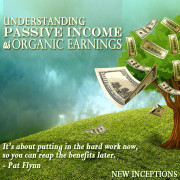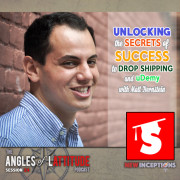Choosing the Right Business Idea for Your Future Success
Last week we came up with a way to make a list of decent ideas for a business. However, these are all ideas and while they might be good ideas, they might not be worth our time in pursuing. So how do we really find out if they’re ideas that we want to pursue and actually pilot? We have to dive a little deeper.
1. Is it Something You’re REALLY Passionate About?
Again, I can’t reiterate enough how important this really is. You must have passion about what it is you’re doing. Recently, the Fizzle crew talked about how doing a business you’re passionate in will be what carries you through the tough times.
See, here’s the thing, if you’re not passionate about what you’re doing (meaning you don’t naturally think or do it), even if you do the following 2 steps, it really doesn’t matter in the end because as soon as a problem comes up, then you’re going to have some issues going forward. The simple truth is if you’re passionate about your idea and you really believe that it will work, then your chances of succeeding increase drastically. You’ll put in the extra effort and extra time to make it all work for you if you have the passion behind it. Plus, you’re more likely to create a better product, which will make your customers happy and more likely to buy from you again in the future.
Think of passion as a necessary part of successful long term business.
2. Is it Something that People are REALLY Actively Looking for or Need?
Just like passion needs to be mentioned again, so does this part. Hopefully you’ve done some market research before just to make sure that your idea is worth keeping. Is there an interest in it? Are people going to use it? Even if you have the best intentions, the worst thing that could happen is that you spend a ton of time and resources building something or things that people aren’t going to utilize.
I’ve seen this way too many times in the tech field. A lot of folks will think “Oh, Idea A is good. So is Idea B. If I put them together to Idea C, I’m sure to win!” This isn’t necessary true. Sometimes it’s possible to make something a little more complex than it needs to be… and that little extra complexity can be a problem for folks.
So how do you test that people want something?
- Ask! – As I mentioned, in the Foundation and via Ryan Levesque, we find that the best way to figure out if a product is going to be utilized is to simply ask. You can ask 10 to 20 people and get an impression of whether or not something is worth pursuing. Remember that if you know a pain so well, that the people you’re asking will think you already have a solution. That’s the point where you make the presale!
- Are the similar sites and businesses already out there? – If you can’t tell, this is the method I used in deciding to pursue New Inceptions. While Pat is focused on passive income, and Fizzle is focused strictly on online businesses, New Inceptions is focused primarily on those of us who have stumbled into this world of business as a second career path. A resource for those who feel that their inner needs and desires were not being met in the work that they were previously doing.
- Do some Keyword research – Similar to the one above, you can check the internet to find out if a given topic is already being used. This is achievable by doing some keyword research. There are tools that are available for this. Google has a free one called the Keyword Planner. One that I’ve been using for years is called Market Samurai.
- Survey Your Already Existing Audience – Perhaps you already have a platform and you’re wanting to offer something new. Instead of asking random people, ask those who have already bought from you once. In fact, those that have already bought from you might realize that your quality is to their standard, so
Remember that when you’re doing this research, it’s not you that’s on trial – it’s the idea. We’d love to believe that all our ideas can make us money, but in reality, it’s up to other people – the market. The best way to see if an idea will sink or not is to find if people will buy in before we ever do the work to do it.
3. Determine Your Scalability
In the passive income world, this is the big question. You don’t want to start a business that the more success you have with it, the more your position consumes you. (However, if you’re a work-a-holic like Gary V, you might actually enjoy that kind of thing.)
Ideally, if you’re in a real passive income setting, the more sales you have, doesn’t necessarily mean you work more. If a million sales suddenly happened one day, would that be a good thing or a bad thing? If you’re pure passive, it’d be an AWESOME thing. It would mean that you wouldn’t have to do ship anything else (as either they get electronic copies or you have another company sending things out) and/or you don’t have to handle accounts payable and receivable – it’s dealt with electronically.
Even if you’re not focused entirely in generating passive income (which, let’s be honest, who isn’t?), you’ll want to think about scalability too. Just in a different perspective. Once you run your idea past a few folks and you know you’d love doing it, think about whether or not you’ll be able to have other people to do it for you. I’m not talking about paying them. Let’s say that’s taken care of. I’m saying, actually have them doing the part you’re doing. Can you train them to do what you do?
If not, then maybe you’re planning on being an artist or musician that makes it so big you that you have orders coming all the time? If so, you’ll want to hire someone to take care of your marketing, office work, and other things you shouldn’t be dealing with. If you’re giving lessons of some sort (say like Roger Love), you might also want to learn how to take care of all the paperwork and marketing that goes into making something like he does successful at his level.
Conclusion:
So, last week, we were collecting ideas that might be part of your overarching theme. This week, we’re inspecting them a little more thoroughly and sorting out the ideas that don’t quite fit. If you follow the above 3 steps, you’re planting some good seeds for a successful business. If you want further help with this subject of choosing a successful business, feel free to take a look at the course in Fizzle called Choosing a Topic by Corbett Barr. Get your first two weeks here free so you can get in without paying a cent.








